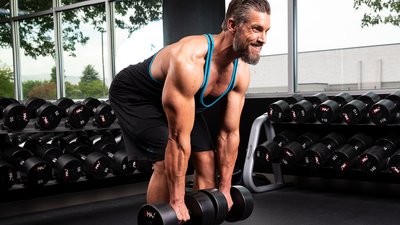I remember it like it was yesterday: With scissors in hand, my role was to cut the duct tape after it was strategically placed over a protruding hiatal hernia on the lifter's abdomen. Once the tape was applied, the lifter would squeeze into a pair of groove briefs and proceed with his heavy deadlifting. The lifter in question, Ric Purchase, had one of the strongest lower backs I'd ever seen. If he had a weakness, it was that because he trained the big lifts almost exclusively, other parts of his body—including his abdomen—became less structurally sound, leading to problems like the hernia.
Mix It Up with Conjugate Training
While Purchase was a minimalistic trainee who did the power lifts and little else, I practiced conjugate training. Rather than focusing on a small number of lifts, conjugate training joins together a number of different training exercises and training styles to create a more well-rounded physique. By varying my workouts, I've stayed healthy for more than 30 years, despite frequent state- and national-level competitions.
We're Not Talking Plastic-Covered Bells Here
One of my favorite conjugate exercises for overall body power is the dumbbell deadlift. I first read about dumbbell deadlifts in the late 1980s in an issue of The Steel Tip, a newsletter from Ken Leistner, DC, a strength-training writer, personal trainer, strength consultant, and chiropractor. More recently, I've watched super-strong Nick Best on Instagram as he performs dumbbell deadlifts (and more) with 150-pounders. Is it any wonder he won his class at the U.S. Powerlifting Championships, and continues to compete in World's Strongest Man contests into his late 40s?

And, if you didn't check out that Nick Best IG post, don't think that dumbbell deadlifts are for lightweights only. I've been fortunate to be a member of such hardcore gyms as Uptown Whittier, Strouds, and the Original Metroflex Gym in Arlington, Texas. Strouds had 200-pound dumbbells, Uptown had pairs to 225 pounds, and Metroflex had them to up to 250 pounds.
I've finished many a maximum-effort lower-body session with reps or even singles using the biggest 'bells in the house. This makes for a fun and challenging workout that's perfect for impromptu contests with your training buddies. Back in the day, Josh Bryant and I used dumbbell deadlifts as part of our conjugate training in preparation for the U.S. Strongest Man Contest. He ended up pulling 885 pounds in the trap bar deadlift, while I got 700 pounds.
Build Flexibility by Extending Your Range of Motion
There are two ways to do the dumbbell deadlift: from the hang or from a dead start. If you're doing them from the hang position, it's best to use the Romanian deadlift style, keeping your back statically tight and loading your hamstrings. This dead-start method loads the oblique muscles, as well as the glutes and hip musculature, by working the muscles through the extended range of motion necessary to pull the dumbbells off the floor.

In my opinion, conjugate exercises tax your body over a longer range of motion than traditional exercises. You typically use lower weight when doing conjugate exercises, which enables you to build not only strength but greater flexibility in the hamstrings, glutes, and hips. These are the same areas that can get tighter when you focus on traditional powerlifting exercises only.
Work Dumbbell Deadlifts Into Your Current Routine
1. Maximum-Effort Deadlift 2 heavy sets of 20 reps
After you're finished pulling heavy barbell deadlifts off the floor, do dumbbell deadlifts RDL style to traction your lower back and stretch your hamstrings.
2. Maximum-Effort Squat 2 heavy sets of 10 reps (or less)
After your barbell squats, do dumbbell deadlifts from the floor for 10 reps with up to 150 pounds. If you have heavier dumbbells than that, lower your reps.
In the true spirit of the conjugate system, you could vary the range of motion of your dumbbell deadlifts by doing them from a deficit, from the plates on boxes, with rep tempo variations, and even with mini bands under your feet and over the bell.
I've trained trap bar deadlifts and farmer's walks for competition, and neither exercise has the same exact training effect as dumbbell deadlifts. Give them an honest try and watch your overall body strength improve dramatically.



